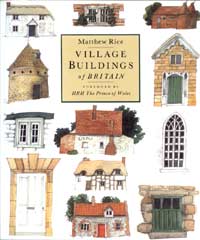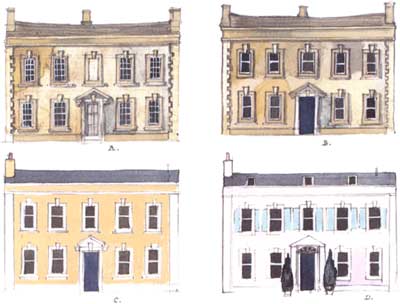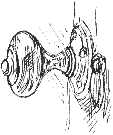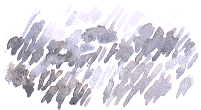The Lost Egg CupsSunday, 8th August 2004 |
|
|||||||||||||||||||||||||||||||||||
|
My Mum was looking forward to ours being returned in sand-blasted, freshly painted condition, but ours was one of those that didn't turn up. The insurance money was welcome but the imitation basketwork white plastic planters that my Mum chose to replace them, though cheerful enough when filled with flowers, never had the cachet of the originals. It wasn't until much later that she invested in the replicas. |
|||||||||||||||||||||||||
Me
(aged 7), Linda and Bill and the Egg Cups |
||||||||||||||||||||||||||
If you're reading this in America, just take a look out of your window would you please? You can't by any chance see our urns?
 I'm
reading Matthew Rice's Village Buildings of Britain.
Arts Review describes his drawings as 'having more body than
Hugh Casson, more line than Paul Hogarth.'
I'm
reading Matthew Rice's Village Buildings of Britain.
Arts Review describes his drawings as 'having more body than
Hugh Casson, more line than Paul Hogarth.'
I met both those enthusiasts of drawing buildings when I was a student at the Royal College of Art in the 1970s and I'm sorry that I didn't learn more from them about their differing approaches to the subject.
As the Arts Review quote implies, Hugh Casson could tend to be rather light in touch in an elegant R.A. watercolourist way.
I wouldn't have said that Paul Hogarth was lacking in line but I feel that some of his work in the 1960s and 1970s suffered from taking on a strand of the international graphics style (gestural and leaning over backwards slightly) that was so fashionable in glossy magazines and colour supplements at the time. I love his early social realist pencil work and his later celebrations of buildings and their context but, his American glossies period; that I'm not so keen on.
Matthew Rice's pencil with light watercolour wash drawings are perfect
for the story he's illustrating. His approach is summed up in his illustration
of 'restoration' (below) in the introduction to his book. I'm
so familiar with the 'over restored' look in example D and I can't help
feeling that, if the owners of such buildings took a look at Rice's book
and then took a look at the traditional buildings around them, we'd still
have a lot more buildings like example A.
 |
||
Here is a house in
four stages of restoration. At each stage another vital part of
the character of the building is lost in the interests of 'improvement'.
Worse still, the owner is under the illusion that he has been responsible
for a sympathetic conversion. |
||
 Village
Buildings isn't really a lament what we've lost: it's more
a celebration of the character and regional variety of vernacular buildings
in England, Wales and Scotland, which we still have in abundance. There's
a useful visual glossary of architectural terms at the end of the book.
Village
Buildings isn't really a lament what we've lost: it's more
a celebration of the character and regional variety of vernacular buildings
in England, Wales and Scotland, which we still have in abundance. There's
a useful visual glossary of architectural terms at the end of the book.
It's a measure of how inspiring the book is that I'm now itching to get out and draw some buildings in the manner of Matthew Rice. My sketch of the reproduction Victorian urn at my Mum's is a small start.
The urns may be gone but the knob on my Mum's front door looks as if it could be the original 1860s fitting.
 Such
gentle rain and so welcome at the end of this sultry day. Barbara and
I stand on the patio for a few moments to enjoy it.
Such
gentle rain and so welcome at the end of this sultry day. Barbara and
I stand on the patio for a few moments to enjoy it.
'You haven't even got your shoes on!' she says.
'Do you wear your shoes when you get in the shower?'
It's a refreshing lukewarm sprinkling, accompanied by that delicious
smell of rain slaking the accumulated warmth of the earth. ![]()
Matthew Rice painter, designer and chicken keeper.
Richard Bell, richard@willowisland.co.uk